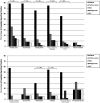National Inpatient Immunization Patterns: Variation in Practice and Policy Between Vaccine Types
- PMID: 33820809
- PMCID: PMC8074110
- DOI: 10.1542/hpeds.2020-002634
National Inpatient Immunization Patterns: Variation in Practice and Policy Between Vaccine Types
Abstract
Background: Many hospitalized children are underimmunized, yet little is known about current systems supporting inpatient vaccination. We aim to describe national pediatric inpatient immunization practices and determine if variation exists among adolescent, childhood, and influenza vaccines.
Methods: An electronic survey regarding hospital vaccination practices was sent to physician, nurse, and pharmacy leaders via the Pediatric Research in Inpatient Settings Network in spring 2019. Hospitals reported the presence of various practices to support inpatient vaccination stratified by vaccine type: tetanus, diphtheria, and acellular pertussis, meningococcal, human papillomavirus, childhood series, and influenza. One-way analysis of variance testing compared differences in numbers of practices and χ2 tests compared proportions of sites reporting each practice between vaccine types. Qualitative responses were evaluated via content analysis.
Results: Fifty-one of 103 eligible hospitals completed the survey (50%). Standardized policies existed in 92% of hospitals for influenza, 41% for childhood, and 29% for adolescent vaccines. Hospitals identified an average of 5.1 practices to deliver influenza vaccines, compared with 1.5 for childhood; 0.9 for tetanus, diphtheria, and acellular pertussis; 0.7 for meningococcal; and 0.6 for human papillomavirus vaccines (P < .001). Standardized screening tools, visual prompts, standing orders, nurse- or pharmacy-driven screening or ordering, staff education, and quality improvement projects were reported more often for influenza vaccines than other vaccine types (P < .01 for all comparisons). Common barriers to delivery included communication difficulties, lack of systems optimization, and parent and provider discomfort with inpatient immunization.
Conclusions: Existing hospital infrastructure supports influenza vaccine delivery over other vaccine types, potentially creating missed inpatient vaccination opportunities.
Copyright © 2021 by the American Academy of Pediatrics.
Conflict of interest statement
POTENTIAL CONFLICT OF INTEREST: The authors have indicated they have no potential conflicts of interest to disclose.
Figures


Similar articles
-
Identifying Practices to Promote Inpatient Adolescent and Influenza Vaccine Delivery.Hosp Pediatr. 2021 Dec 1:hpeds.2021-005924. doi: 10.1542/hpeds.2021-005924. Online ahead of print. Hosp Pediatr. 2021. PMID: 34807982
-
Facilitators and barriers to the use of standing orders for vaccination in obstetrics and gynecology settings.Am J Obstet Gynecol. 2017 Jan;216(1):69.e1-69.e7. doi: 10.1016/j.ajog.2016.09.096. Epub 2016 Sep 26. Am J Obstet Gynecol. 2017. PMID: 27687213
-
Using the 4 Pillars™ Practice Transformation Program to increase adolescent human papillomavirus, meningococcal, tetanus-diphtheria-pertussis and influenza vaccination.Vaccine. 2017 Oct 27;35(45):6180-6186. doi: 10.1016/j.vaccine.2017.09.039. Epub 2017 Sep 22. Vaccine. 2017. PMID: 28947346 Free PMC article. Clinical Trial.
-
The Need to Optimize Adolescent Immunization.Pediatrics. 2017 Mar;139(3):e20164186. doi: 10.1542/peds.2016-4186. Epub 2017 Feb 6. Pediatrics. 2017. PMID: 28167517 Review.
-
Child and adolescent immunizations: selected review of recent US recommendations and literature.Curr Opin Pediatr. 2014 Jun;26(3):383-95. doi: 10.1097/MOP.0000000000000093. Curr Opin Pediatr. 2014. PMID: 24722457 Review.
Cited by
-
Vaccine Administration in Children's Hospitals.Pediatrics. 2022 Feb 1;149(2):e2021053925. doi: 10.1542/peds.2021-053925. Pediatrics. 2022. PMID: 35001100 Free PMC article.
References
-
- Pahud B, Clark S, Herigon JC, et al. . A pilot program to improve vaccination status for hospitalized children. Hosp Pediatr. 2015;5(1):35–41 - PubMed
-
- Weddle G, Jackson MA. Vaccine eligibility in hospitalized children: spotlight on a unique healthcare opportunity. J Pediatr Health Care. 2014;28(2):148–154 - PubMed
-
- Bell LM, Pritchard M, Anderko R, Levenson R. A program to immunize hospitalized preschool-aged children: evaluation and impact. Pediatrics. 1997;100(2 pt 1):192–196 - PubMed
-
- Kum-Nji P, James D, Herrod HG. Immunization status of hospitalized preschool children: risk factors associated with inadequate immunization. Pediatrics. 1995;96(3 pt 1):434–438 - PubMed
Publication types
MeSH terms
Substances
Grants and funding
LinkOut - more resources
Full Text Sources
Other Literature Sources
Medical

